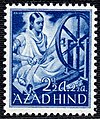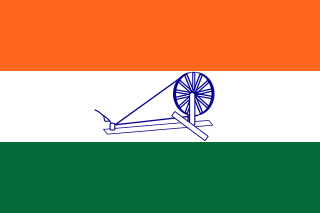
The Indian National Army was a collaborationist armed unit of Indian collaborators that fought under the command of the Japanese Empire. It was founded on 1 September 1942 in Southeast Asia during World War II.

Subhas Chandra Bose was an Indian nationalist whose defiance of British authority in India made him a hero among many Indians, but his wartime alliances with Nazi Germany and Imperial Japan left a legacy vexed by authoritarianism, anti-Semitism, and military failure. The honorific Netaji was first applied to Bose in Germany in early 1942—by the Indian soldiers of the Indische Legion and by the German and Indian officials in the Special Bureau for India in Berlin. It is now used throughout India.

Indian postal systems for efficient military and governmental communications had developed long before the arrival of Europeans. When the Portuguese, Dutch, French, Danish and British conquered the Marathas who had already defeated the Mughals, their postal systems existed alongside those of many somewhat independent states. The British East India Company gradually annexed the other powers on the sub-continent and brought into existence a British administrative system over most of modern-day India, with a need to establish and maintain both official and commercial mail systems.

Azad Hind, officially the Provisional Government of Free India, was a short-lived Japanese-supported provisional government in India. It was established in Japanese occupied Singapore during World War II in October 1943 and has been considered a puppet state of the Empire of Japan.
Azad Hind Radio was a radio service that was started under the leadership of Subhas Chandra Bose and Adolf Hitler in Nazi Germany in 1942 to encourage Indians to fight for the Axis powers. Though initially based in Nazi Germany, its headquarters were shifted to Japanese occupied Singapore, and later to Hyderabad, following the course of the war in Southeast Asia. After Netaji's departure to Southeast Asia, the German operations were continued by A.C.N. Nambiar, the head of the Indian Legion in Nazi Germany and later ambassador of the Arzi Hukumate Azad Hind in Germany.

Netaji Subhas Chandra Bose: The Forgotten Hero is a 2004 Indian epic biographical war film, written and directed by Shyam Benegal. The film starred an ensemble cast of Sachin Khedekar, Kulbhushan Kharbanda, Rajit Kapur, Arif Zakaria, and Divya Dutta, among others. The film depicts the life of the Indian Independence leader Subhas Chandra Bose in Nazi Germany: 1941–1943, and In Japanese-occupied Asia 1943–1945, and the events leading to the formation of Azad Hind Fauj.

The history of postage stamps and postal history of Malaysia, a state in Southeast Asia that occupies the south of the Malay peninsula and Sarawak and Sabah in the north Borneo, includes the development of postal services in these periods:

The Indian Legion, officially the Free India Legion or 950th (Indian) Infantry Regiment, was a military unit raised during the Second World War initially as part of the German Army and later the Waffen-SS from August 1944. Intended to serve as a liberation force for British-ruled India, it was made up of Indian prisoners of war and expatriates in Europe. Due to its origins in the Indian independence movement, it was known also as the "Tiger Legion", and the "Azad Hind Fauj". As part of the Waffen-SS it was known as the Indian Volunteer Legion of the Waffen-SS.

Shah Nawaz Khan was an Indian politician who served as an officer in the Indian National Army (INA) during World War II. He was profoundly influenced by Subhas Chandra Bose's speeches asking POWs to join the Indian National Army and to fight for a free India, Khan led the army into North-Eastern India, seizing Kohima and Imphal which were held briefly by the INA under the authority of the Japanese. In December 1944, Shah Nawaz Khan was appointed Commander of the 1st Division at Mandalay. After the war, he was tried, convicted for treason, and sentenced to death in a public court-martial carried out by the British Indian Army. The sentence was commuted by the Commander-in-chief of the Indian Army following unrest and protests in India. After the trial, Khan declared that he would henceforth follow the path of non-violence espoused by Mahatama Gandhi and he joined the Congress party. Having successfully contested the first Lok Sabha in 1952 from Meerut, Khan had an illustrious parliamentary career. He was elected four times to the Lok Sabha from Meerut constituency in 1951, 1957, 1962 and 1971. He lost in the 1967 and 1977 Lok Sabha election from Meerut.

The Indian National Army trials was the British Indian trial by court-martial of a number of officers of the Indian National Army (INA) between November 1945 and May 1946, on various charges of treason, torture, murder and abetment to murder, during the Second World War.
John Thivy (1904–1959) was a Malayan Indian politician and former lawyer who was the founding president of the Malayan Indian Congress.
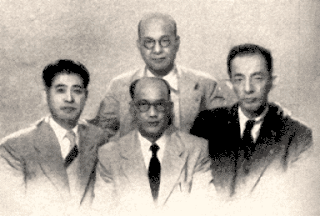
Subbier Appadurai Ayer was the Minister for Publicity and Propaganda in Subhas Chandra Bose's Azad Hind Government between 1943 and 1945, and later a key defence witness during the first of the INA trials. Ayer had travelled to Bangkok in November 1940 as a Special correspondent for Reuters before joining the Indian Independence League. In October 1943, Ayer was appointed the Minister of publicity and propaganda in the nascent Azad Hind Government.
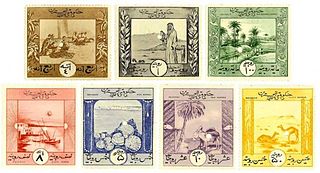
The first revenue stamps of Bahrain were issued in 1924. Before then Indian revenue stamps were used on documents. Revenue stamps have been used for Land Registry documents, drivers permits and the Dhow Registry.
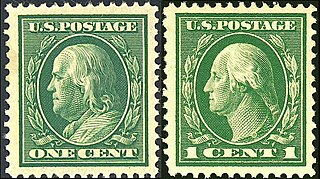
The Washington–Franklin Issues are a series of definitive U.S. Postage stamps depicting George Washington and Benjamin Franklin, issued by the U.S. Post Office between 1908 and 1922. The distinctive feature of this issue is that it employs only two engraved heads set in ovals—Washington and Franklin in full profile—and replicates one or another of these portraits on every stamp denomination in the series. This is a significant departure from previous definitive issues, which had featured pantheons of famous Americans, with each portrait-image confined to a single denomination. At the same time, this break with the recent past represented a return to origins. Washington and Franklin, after all, had appeared on the first two American stamps, issued in 1847, and during the next fifteen years, each of the eight stamp denominations available featured either Washington or Franklin.

Throughout World War II, both the Axis and Allied sides used propaganda to sway the opinions of Indian civilians and troops, while at the same time Indian nationalists applied propaganda both within and outside India to promote the cause of Indian independence.

The Free India Centre was the European branch of the Azad Hind, provisional government led by Subhas Chandra Bose. It was founded by Bose when he was in Nazi Germany in 1942, and headed by A. C. N. Nambiar.
The Indian National Army (INA) and its leader Subhash Chandra Bose are popular and emotive topics within India. From the time it came into public perception in India around the time of the Red Fort Trials, it found its way into the works of military historians around the world. It has been the subject of a number of projects, of academic, historical and of popular nature. Some of these are critical of the army, some — especially of the ex-INA men — are biographical or autobiographical, while still others historical and political works, that tell the story of the INA. A large number of these provide analyses of Subhas Chandra Bose and his work with the INA.
The INA treasure controversy relates to alleged misappropriation by men of Azad Hind of the Azad Hind fortune recovered from belongings of Subhas Chandra Bose in his last known journey. The treasure, a considerable amount of gold ornaments and gems, is said to have been recovered from Bose's belongings following the fatal plane crash in Formosa that reportedly killed him, and taken to men of Azad Hind then living in Japan. The Indian government was made aware of a number of these individuals allegedly using part of the recovered treasure for personal use. However, despite repeated warnings from Indian diplomats in Tokyo, Nehru is said to have disregarded allegations that men previously associated with Azad Hind misappropriated the funds for personal benefit. Some of these are said to have travelled to Japan repeatedly with the approval of Nehru government and were later given government roles implementing Nehru's political and economic agenda. A very small portion of the alleged treasure was repatriated to India in the 1950s.

Netaji Jayanti or Netaji Subhas Chandra Bose Jayanti, officially known as Parakram Diwas or Parakram Divas, is a national event celebrated in India to mark the birthday of the prominent Indian freedom fighter Netaji Subhas Chandra Bose. It is celebrated annually on 23 January. He played a pivotal role in Indian independence movement. He was the head of Indian National Army. He was the founder-head of the Azad Hind Government.



